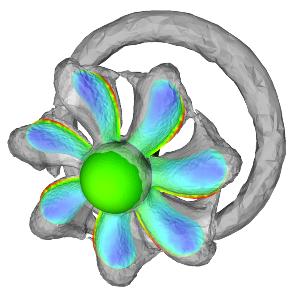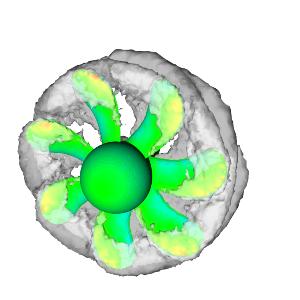
Figure 5: Flow around a propeller: Pressure field on the propeller surface and single iso-surface.

Figure 6: Flow around a propeller: Helicity field on the propeller surface and single iso-surface.
Application pages:
|
Figure 5: Flow around a propeller: Pressure field on the propeller surface and single iso-surface.
Figure 6: Flow around a propeller: Helicity field on the propeller surface and single iso-surface. |
Another application of the stabilized space-time formulation has been found
in modeling of geometries which undergo large regular deformations, such as
rotations or translations of their individual elements. Only simplest cases
in this category can be modeled by adjusting the frame of reference. When the
motion of the elements is with respect to each other, that simple approach
fails. Another way of handling these problems is to adjust the interior mesh
as described in the previous section and then remesh. Remeshing, defined as
creating new finite element mesh with a new connectivity, necessitates
projection of the old solution onto the new mesh, which generally results in
smearing of features of the solution. However, with the use of custom designed
meshes, certain motions of the domain boundaries can be accommodated by
repetitive deformation of elements within the time step, followed by frequent
regeneration of element connectivity. The goal of the special mesh design is
the matching of the node positions of the old (deformed) and the new
(good-quality) meshes, so that projection is not necessary. In the case of
rotation of an internal component, the object is surrounded by a disc of rigid
mesh rotating with the component. This disc is in turn surrounded by
stationary mesh spanning the external non-moving boundaries. Between the two
subdomains, one can place a layer of elements which deform to absorb the
motion of the internal disc, and then reconnect to new nodes on the surface of
that disc, providing a mesh of the same quality as the original one. Figure 5
shows, at an instant during the simulation, the pressure field on the surface
and in the vicinity of a propeller, which is immersed in a high-Reynolds
number uniform flow. Figure 6 shows the corresponding helicity patterns.
The layer of deforming elements is unnoticeable in the solution, and
significant thrust is being generated in this simulation.
Application of this methodology may include studies of flow
interaction between a helicopter rotor or a submarine propeller,
and fuselage and hull, respectively. Application pages: |